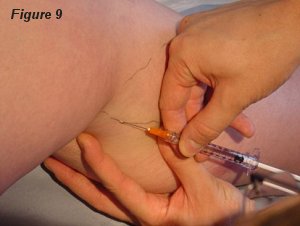1. About the treatment.
Injection (sclerosant) therapy is usually only suitable for relatively small varicose veins and thread veins. It works by making the vein wall stick to itself, thus obliterating it, and the compression applied after the injection is an essential part of the therapy.
2. Before your injection.
You may have to stop taking the oral contraceptive pill, which could increase the risk of a serious thrombosis or “clot”. This should be stopped one month before your appointment but it is very important to think about other contraception methods. There is little evidence that low dose “mini-pills” and hormone replacement therapy (HRT) need to be stopped.
You may need to be given a test injection to check that you are not allergic to the treatment.
If you have a job that involves a lot of standing, please arrange to have a few days off after the injection or ask for you to be given a dispensation to sit down or walk regularly.
A Class 2 compression stocking will be applied to guard against blood clots and to promote healing. These are to be worn for 48 hours continuously, and then a week daytime only. They can be obtained in a local pharmacy, John Bell and Croyden Wigmore St W1, or online at www.daylong.co.uk
3. At the clinic.
A small amount of fluid is injected into the vein at one or more sites and a cotton wool pledget or rubber pad applied (Figures 9,10). A bandage is then put onto the leg and the stocking applied to prevent the bandage from working loose.
Depending on the number and location of injections you may be able to drive yourself home from the clinic, but ask when booking. Otherwise arrange for somebody to collect you or take transport.
4. Afterwards.
Take a few short 20 minute walks every day and try to avoid standing still for any length of time.
After 48 hours you may remove the bandage and cotton wool pads and replace the stocking. This should be worn at all times during the day but can be removed in bed and when taking a bath or shower. You can undertake light exercise (treadmill, gentle swimming) after 2 days, but try to avoid hot baths or saunas.
The success of the injection treatment partly relies upon the pressure that the bandages and stocking apply to the injected area. Wear the stocking until the leg is completely comfortable on standing and for at least 1-2weeks, unless the doctor tells you that it can be removed earlier. The stocking may be removed temporarily for bathing and whenever the leg is elevated, or at night.
5. What to expect after the injections.
Over the first few weeks following the injection there may be slight discomfort, hardness or tenderness at the injection site(s) and this should gradually subside. If there is excessive redness, swelling or tenderness, this means you should rest more with the leg raised so that the heel is higher than the hip.
While most patients experience no problems after injection of varicose veins, a small number may experience one or more of the following:
- A persistent hard “cord” in the line of the vein.
- Brown staining of the skin in the line of the vein.
- Rarely, ulceration of the skin at the injected site.
- Failure of the injection to obliterate the vein.
Allergic reactions after sclerotherapy are rare as is deep vein thrombosis – if you have a personal or family history of either you should tell us first. For the future it may be advisable for you to wear light support stockings or tights to try to prevent the occurrence of further varicose veins.
6. Eventual result
The aim of the injections is to reduce the size of the varicose veins and make them less visible. Hopefully this will reduce the amount of aching from them. However, some patients do not find any improvement following injections, and other methods such as surgical removal may then have to be used. As with any kind of intervention it is impossible to guarantee any particular cosmetic result.
 Injection of veins Injection of veins |
 |
